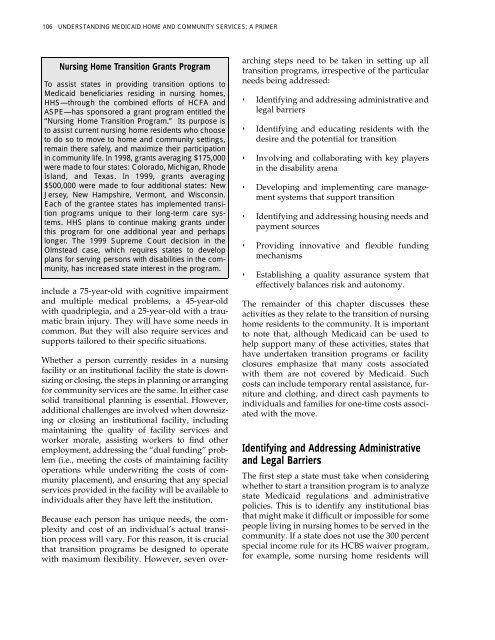Full PDF Version - ASPE - U.S. Department of Health and Human ...
Full PDF Version - ASPE - U.S. Department of Health and Human ...
Full PDF Version - ASPE - U.S. Department of Health and Human ...
- No tags were found...
You also want an ePaper? Increase the reach of your titles
YUMPU automatically turns print PDFs into web optimized ePapers that Google loves.
106 UNDERSTANDING MEDICAID HOME AND COMMUNITY SERVICES: A PRIMERNursing Home Transition Grants ProgramTo assist states in providing transition options toMedicaid beneficiaries residing in nursing homes,HHS—through the combined efforts <strong>of</strong> HCFA <strong>and</strong><strong>ASPE</strong>—has sponsored a grant program entitled the“Nursing Home Transition Program.” Its purpose isto assist current nursing home residents who chooseto do so to move to home <strong>and</strong> community settings,remain there safely, <strong>and</strong> maximize their participationin community life. In 1998, grants averaging $175,000were made to four states: Colorado, Michigan, RhodeIsl<strong>and</strong>, <strong>and</strong> Texas. In 1999, grants averaging$500,000 were made to four additional states: NewJersey, New Hampshire, Vermont, <strong>and</strong> Wisconsin.Each <strong>of</strong> the grantee states has implemented transitionprograms unique to their long-term care systems.HHS plans to continue making grants underthis program for one additional year <strong>and</strong> perhapslonger. The 1999 Supreme Court decision in theOlmstead case, which requires states to developplans for serving persons with disabilities in the community,has increased state interest in the program.include a 75-year-old with cognitive impairment<strong>and</strong> multiple medical problems, a 45-year-oldwith quadriplegia, <strong>and</strong> a 25-year-old with a traumaticbrain injury. They will have some needs incommon. But they will also require services <strong>and</strong>supports tailored to their specific situations.Whether a person currently resides in a nursingfacility or an institutional facility the state is downsizingor closing, the steps in planning or arrangingfor community services are the same. In either casesolid transitional planning is essential. However,additional challenges are involved when downsizingor closing an institutional facility, includingmaintaining the quality <strong>of</strong> facility services <strong>and</strong>worker morale, assisting workers to find otheremployment, addressing the “dual funding” problem(i.e., meeting the costs <strong>of</strong> maintaining facilityoperations while underwriting the costs <strong>of</strong> communityplacement), <strong>and</strong> ensuring that any specialservices provided in the facility will be available toindividuals after they have left the institution.Because each person has unique needs, the complexity<strong>and</strong> cost <strong>of</strong> an individual’s actual transitionprocess will vary. For this reason, it is crucialthat transition programs be designed to operatewith maximum flexibility. However, seven overarchingsteps need to be taken in setting up alltransition programs, irrespective <strong>of</strong> the particularneeds being addressed:• Identifying <strong>and</strong> addressing administrative <strong>and</strong>legal barriers• Identifying <strong>and</strong> educating residents with thedesire <strong>and</strong> the potential for transition• Involving <strong>and</strong> collaborating with key playersin the disability arena• Developing <strong>and</strong> implementing care managementsystems that support transition• Identifying <strong>and</strong> addressing housing needs <strong>and</strong>payment sources• Providing innovative <strong>and</strong> flexible fundingmechanisms• Establishing a quality assurance system thateffectively balances risk <strong>and</strong> autonomy.The remainder <strong>of</strong> this chapter discusses theseactivities as they relate to the transition <strong>of</strong> nursinghome residents to the community. It is importantto note that, although Medicaid can be used tohelp support many <strong>of</strong> these activities, states thathave undertaken transition programs or facilityclosures emphasize that many costs associatedwith them are not covered by Medicaid. Suchcosts can include temporary rental assistance, furniture<strong>and</strong> clothing, <strong>and</strong> direct cash payments toindividuals <strong>and</strong> families for one-time costs associatedwith the move.Identifying <strong>and</strong> Addressing Administrative<strong>and</strong> Legal BarriersThe first step a state must take when consideringwhether to start a transition program is to analyzestate Medicaid regulations <strong>and</strong> administrativepolicies. This is to identify any institutional biasthat might make it difficult or impossible for somepeople living in nursing homes to be served in thecommunity. If a state does not use the 300 percentspecial income rule for its HCBS waiver program,for example, some nursing home residents will
















